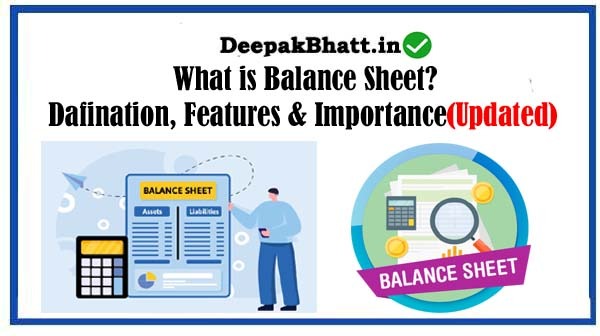what is Balance Sheet In the realm of finance, where numbers tell the story of an organization’s fiscal health, the balance sheet takes center stage.
It’s not just a document; it’s a financial snapshot, a mirror reflecting the assets, liabilities, and equity that shape the financial standing of a business.
In this comprehensive guide, we’ll unravel the intricacies of the balance sheet, exploring its definition, components, significance, and how it serves as a crucial tool for assessing financial stability.
- 1 What is Balance Sheet
- 1.1 Components of the Balance Sheet
- 1.2 1. Assets
- 1.3 a. Current Assets:
- 1.4 b. Non-Current Assets:
- 1.5 2. Liabilities
- 1.6 a. Current Liabilities:
- 1.7 b. Non-Current Liabilities:
- 1.8 3. Equity
- 1.9 a. Common Stock:
- 1.10 b. Retained Earnings:
- 1.11 c. Additional Paid-in Capital:
- 1.12 Significance of the Balance Sheet
- 1.13 1. Financial Health Assessment
- 1.14 2. Investor Decision-Making
- 1.15 3. Creditworthiness Evaluation
- 1.16 4. Strategic Planning
- 1.17 Analyzing the Balance Sheet
- 1.18 1. Liquidity Ratios
- 1.19 2. Debt Ratios
- 1.20 3. Asset Turnover Ratios
- 1.21 4. Return on Equity (ROE)
- 1.22 Common Balance Sheet Pitfalls
- 1.23 1. Overlooking Off-Balance Sheet Items
- 1.24 2. Failure to Adjust for Market Value
- 1.25 3. Ignoring Timing Differences
- 1.26 Future Trends in Financial Reporting
- 1.27 1. Integrated Reporting
- 1.28 2. Environmental, Social, and Governance (ESG) Reporting
What is Balance Sheet
A balance sheet, also known as a statement of financial position, is a financial statement that provides a snapshot of an entity’s financial position at a specific point in time.
It presents a summary of what a business owns (assets), what it owes (liabilities), and the residual interest of the owners (equity).
The name “balance sheet” reflects the fundamental accounting equation: Assets = Liabilities + Equity.
What is Capital? Defination, Types & Concept
What is Loss? Defination, Types & Concept
What is Profit? Defination, Types & Concept
Components of the Balance Sheet
1. Assets
Assets represent everything a company owns that has economic value. They are categorized into two main types:
a. Current Assets:
These are assets expected to be converted into cash or used up within one year. Examples include cash, accounts receivable, inventory, and short-term investments.
b. Non-Current Assets:
These are assets with a longer lifespan, typically more than one year. Examples include property, plant, equipment, intangible assets, and long-term investments.
2. Liabilities
Liabilities encompass all the financial obligations a company owes to external parties. Like assets, liabilities are divided into current and non-current categories:
a. Current Liabilities:
These are obligations due within one year, such as accounts payable, short-term loans, and accrued expenses.
b. Non-Current Liabilities:
These are long-term obligations extending beyond one year. Examples include long-term debt, deferred tax liabilities, and pension obligations.
3. Equity
Equity, also known as shareholders’ equity or owner’s equity, represents the residual interest in the company’s assets after deducting liabilities. It reflects the ownership claim on the company’s assets and is calculated as:
Equity=Assets−LiabilitiesEquity=Assets−Liabilities
Equity includes:
a. Common Stock:
The capital raised through the issuance of common stock.
b. Retained Earnings:
Accumulated profits or losses that have not been distributed as dividends.
c. Additional Paid-in Capital:
Capital received from investors in excess of the par value of the common stock.
Significance of the Balance Sheet
1. Financial Health Assessment
The balance sheet is a critical tool for assessing the financial health and stability of a business. By examining the relationship between assets, liabilities, and equity, stakeholders can gauge solvency and liquidity, providing insights into the organization’s ability to meet its short-term and long-term obligations.
2. Investor Decision-Making
Investors rely on balance sheets to make informed investment decisions. A healthy balance sheet with a strong asset base and manageable liabilities signals financial stability and can attract potential investors.
3. Creditworthiness Evaluation
Creditors use balance sheets to evaluate a company’s creditworthiness. A company with a strong asset base and manageable debt is generally considered less risky and more likely to meet its financial obligations.
4. Strategic Planning
Balance sheets play a crucial role in strategic planning. They provide insights into the availability of resources for future investments, expansion opportunities, and potential areas for cost management.
Analyzing the Balance Sheet
1. Liquidity Ratios
Liquidity ratios assess a company’s ability to meet its short-term obligations. Common liquidity ratios derived from the balance sheet include the current ratio (current assets divided by current liabilities) and the quick ratio (current assets excluding inventory divided by current liabilities).
2. Debt Ratios
Debt ratios evaluate a company’s leverage and its ability to manage long-term debt. The debt-to-equity ratio (total debt divided by total equity) is a commonly used metric derived from the balance sheet.
3. Asset Turnover Ratios
Asset turnover ratios measure how efficiently a company utilizes its assets to generate revenue. These ratios are derived by comparing revenue to different categories of assets, such as total assets, current assets, or fixed assets.
4. Return on Equity (ROE)
ROE is a profitability ratio that assesses the return generated on shareholders’ equity. It is calculated by dividing net income by average shareholders’ equity and is often used in conjunction with the balance sheet.
Common Balance Sheet Pitfalls
1. Overlooking Off-Balance Sheet Items
While the balance sheet provides a comprehensive view, certain items may not be explicitly listed. Off-balance sheet items, such as operating leases or contingent liabilities, can impact a company’s financial position and should be considered when analyzing its health.
2. Failure to Adjust for Market Value
The balance sheet typically records assets at historical cost, which may differ from their market value. Companies should consider adjusting for market value when assessing the true worth of assets.
3. Ignoring Timing Differences
Timing differences between recognizing revenue and incurring expenses can affect the accuracy of financial statements. Companies need to carefully manage these timing differences to provide a more accurate representation of their financial position.
Future Trends in Financial Reporting
1. Integrated Reporting
Integrated reporting aims to provide a holistic view of a company’s value creation over time. It combines financial and non-financial information, offering stakeholders a more comprehensive understanding of a company’s performance.
2. Environmental, Social, and Governance (ESG) Reporting
ESG reporting is gaining prominence as companies recognize the importance of disclosing their impact on the environment, society, and governance. ESG metrics are increasingly being integrated into financial reporting, providing stakeholders with a broader perspective on a company’s sustainability practices.
Master the Basics of Finance for professionals Video Course
Business Finance Essentials Fundamental Concepts with Tutorial

















